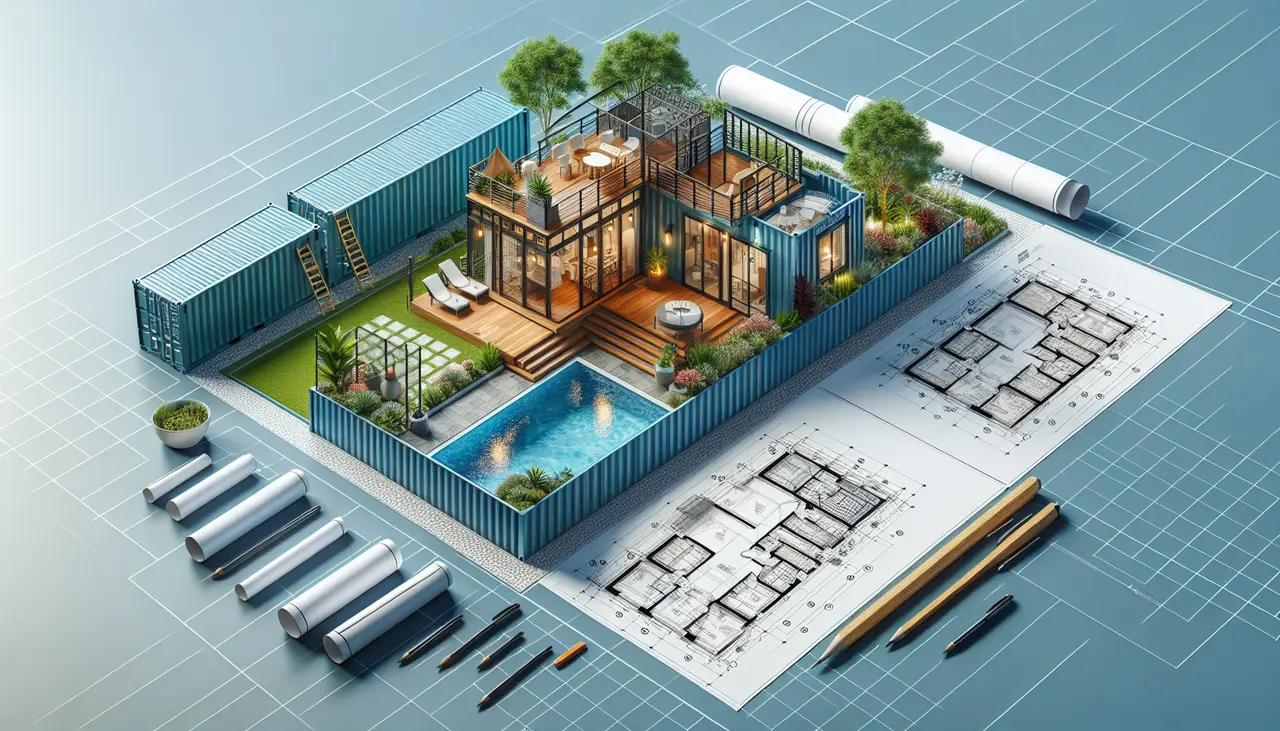Introduction to Custom Homes Made with Shipping Containers
Shipping container homes are changing the game in modern home building. Imagine taking those big metal boxes, used for transporting goods across oceans, and turning them into your dream house. Sounds pretty cool, right? This is exactly what many people are doing, and it’s not just about being trendy. Building a home out of shipping containers can be cost-effective, environmentally friendly, and incredibly versatile.
Whether you want a simple, small dwelling or a sprawling complex, shipping containers can be stacked and modified to create almost any layout you dream of. Plus, the strong steel frame of containers makes them resilient against harsh weather, adding an extra layer of security for your home. So, if you’re thinking outside the traditional brick-and-mortar box for your next home project, shipping container homes could be the innovative solution you’re looking for.
Why Choose Shipping Containers for Your Custom Home?
Shipping containers make for a unique choice in building your dream custom home, and here’s why. First off, they are eco-friendly. Reusing these metal boxes means fewer materials go to waste. Plus, they’re incredibly durable. Designed to withstand tough sea conditions, shipping containers can handle almost any weather on land too.
They’re also cost-effective. Compared to traditional building materials, you’ll often spend less money turning a shipping container into a cozy living space. What’s more, they offer flexibility in design. You can stack them, cut them, and arrange them in numerous ways to fit your vision. Lastly, shipping container homes can be built faster than conventional houses. So, if you’re looking to move into your dream home quickly, shipping containers might just be the way to go.
The Types of Shipping Containers Available for Home Building
When building a custom home from shipping containers, you have choices to make. Not all containers are the same. Standard containers come in two sizes: 20 feet and 40 feet. They’re what you see on ships and trucks. Most people use these for homes because they’re strong and a good size. There are also high-cube containers.
They’re like standard ones but a foot taller. This extra space can make your home feel less cramped. Plus, there’s the open-top container. If you want a house with a high ceiling or maybe even a greenhouse, this is your pick. They’re standard size but with no fixed roof. Remember, the type of container you choose affects your home’s design and feel. Choose wisely based on what you need from your dream home.
Planning Your Dream Custom Home: Getting Started
Starting the journey to your dream custom home made from shipping containers is both exciting and challenging. The key to success lies in planning. Every big project starts with a clear goal and a plan to make it happen. First, decide on your budget. Knowing how much you can spend sets the stage for all other decisions. Next, understand your needs and wants. How many rooms do you need? Do you want an open-plan living space?
Thinking about these questions early ensures your home fits your lifestyle. Location is crucial, too. The land you choose impacts the design and construction process. Make sure it’s suitable for a shipping container home. Finally, research local building codes and regulations. These rules can vary widely between areas and will influence your project’s scope and execution. With these steps, you’re on your way to creating a home that’s uniquely yours. Remember, planning is powerful. It turns dreams into achievable goals.
Designing Your Shipping Container Home: Must-Know Tips
When you dive into designing your shipping container home, think simple yet efficient. First off, decide how much space you need. Do you want a cozy one-container studio or a sprawling multi-container family home? You can stack containers for multiple floors or spread them out for a single-level living area. Next, consider your climate.
Insulation is key to making your container home comfortable, whether it’s beating the heat or staying warm. Windows and doors aren’t just for views and exits; they’re your ticket to natural light and ventilation, so place them strategically. Also, remember, shipping containers are steel boxes – they conduct heat and cold. That’s where clever insulation comes in, keeping you cool in summer and cozy in winter.
Plan your utilities like plumbing, electricity, and internet early. It’s easier to incorporate them into your design from the start than to retrofit. Lastly, let your creativity fly when choosing finishes. You’re not stuck with the industrial look. Wood, glass, and modern materials can transform your container into a stylish, comfortable home. Keep it straightforward, focus on functionality, and your shipping container home will turn heads and be a joy to live in.
Legal Considerations and Permits for Building Custom Homes with Shipping Containers
When you set your heart on building your dream home out of shipping containers, dealing with legal stuff might seem like a drag. Yet, it’s crucial. Before you let your imagination run wild, you need to get the green light from those in charge. This means zoning laws, building codes, and permits. Every place has its own set of rules. Some areas embrace shipping container homes, while others… not so much. It’s a make-or-break deal, so do your homework.
Zoning laws decide where you can build and what the area’s intended for. No use planning a house where it’s not allowed. Building codes ensure your dream home is safe and up to snuff. They cover everything from structure to electrical wiring. Ignoring these can lead to nasty surprises down the road.
Now, for permits, you’re basically asking permission to build. This step can’t be skipped or sidelined. Without the right permits, you could be forced to take down your home, even if it’s nearly finished. Start at your local building authority or planning office. Be prepared with your design plans, and be clear about what you’re doing. They’ve seen it all, and they’re there to help, not hinder.
In short, sorting out the legalities isn’t just a checkbox on your dream home journey. It shapes your project’s path. So, get it right, and you’re one major step closer to living in your shipping container masterpiece.
The Construction Process: Transforming Containers into a Home
Turning shipping containers into a dream home is a unique process that consists of several key steps. First, you need to get the right containers. These steel boxes come in different sizes, usually 20 or 40 feet long. Choose based on the size of your dream home. Second, design your home. This step might involve architects or designers familiar with container homes to ensure your vision is practical and meets building codes. Next, prepare your land.
This includes clearing, leveling, and possibly adding a foundation to place your containers on. Now comes the exciting part – modifying the containers. You’ll cut openings for doors, windows, and remove parts of the steel to create room connections. This work often requires professionals with the right tools and safety equipment. After that, it’s time to connect utilities like water, electricity, and sewage. This might be complex, depending on your location.
Finally, you’ll finish the interior and exterior according to your taste. Insulation, interior walls, flooring, and paint transform the industrial containers into a cozy, inviting space. Exterior finishes can include paint, cladding, or even green walls. Each step in this process is crucial to turn these robust, rectangular boxes into a home that’s not just habitable but comfortable and stylish. Remember, while building with containers can be cost-effective and eco-friendly, it requires careful planning and execution to get right.
Insulation, Wiring, and Plumbing Essentials for Container Homes
Insulation is key in turning a cold, echoey shipping container into a cozy home. For hot climates, spray foam insulation is a champ. It seals tight spaces, keeping the cool in and the heat out. In cooler areas, you might consider panel insulation. It’s easy to fit but make sure it’s the fire-resistant kind to keep you safe. Wiring and plumbing aren’t as daunting as they sound. Most times, these systems are installed before the interior walls go up. It makes sense – easier to run pipes and wires without walls in the way. Here’s the deal: you’ll need a skilled professional for this. Yes, it costs, but cutting corners on electrical work and plumbing can backfire, big time. Remember, everything needs to be up to code. Your local building authority isn’t going to cut you slack just because you’re using shipping containers. Cross your t’s and dot your i’s on this one. Safety first, always.
Interior Design Ideas for Shipping Container Custom Homes
When it comes to the interior design of shipping container custom homes, the possibilities are endless. These steel boxes can transform into cozy, modern, or utterly unique living spaces. One key advantage is their modular design, allowing you to play with different layouts to create your dream home.
First, think about maximizing space. Shipping containers aren’t huge, so clever storage solutions are a must. Built-in cabinets and multi-functional furniture can help keep your place organized and spacious.
Lighting is another critical factor. Large windows and skylights not only bring in natural light but also make rooms appear larger. Combine this with bright, reflective colors for walls and ceilings, and your container home will feel airy and welcoming.
Insulation is essential for comfort. Properly insulating your shipping container home will keep it cool in summer and warm in winter. It also helps to prevent condensation, which can lead to mold.
Lastly, don’t forget to add personal touches. Artwork, rugs, and unique furniture pieces turn a steel box into your cozy haven. With the right approach, your shipping container home can be as stylish and comfortable as any traditional home.
Cost Analysis and Budgeting for Your Shipping Container Dream Home
Building your dream home from shipping containers is more budget-friendly than traditional housing, but it’s not pocket change. The cost of a shipping container can start from as low as $2,000 for a used one to around $6,000 for a new one.
However, don’t let these numbers fool you; turning these steel boxes into a cozy home involves more than just the purchase price. You need to consider insulation, electricity, plumbing, and interior finishes. Also, the larger and more complex your design, the higher the cost. On average, expect to spend (10,000 to )35,000 per container for a fully functional home. Remember, the total cost includes land, permits, foundation, and utility connections.
Budgeting smartly and keeping a tight rein on your expenses will keep your project from becoming a financial nightmare. Quality matters, but so does creativity in cutting costs without cutting corners. With the right approach, your shipping container dream home can become a reality within a reasonable budget.

